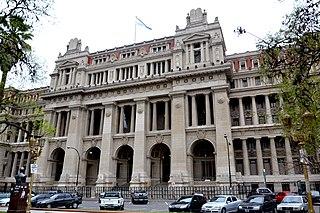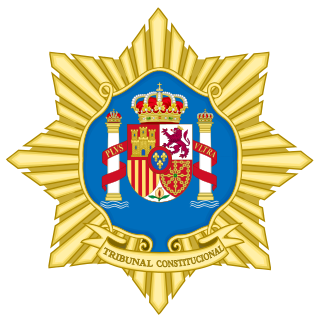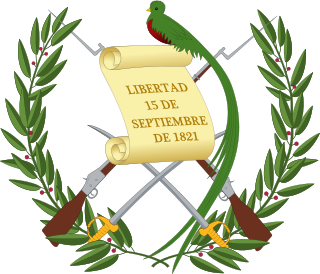Politics of Guatemala takes place in a framework of a presidential representative democratic republic, where by the President of Guatemala is both head of state, head of government, and of a multi-party system. Executive power is exercised by the government. Legislative power is vested in both the government and the Congress of the Republic. The judiciary is independent of the executive and the legislature. Guatemala is a Constitutional Republic.

José Efraín Ríos Montt was a Guatemalan military officer, politician, and dictator who served as de facto President of Guatemala from 1982 to 1983. His brief tenure as chief executive was one of the bloodiest periods in the long-running Guatemalan Civil War. Ríos Montt's counter-insurgency strategies significantly weakened the Marxist guerrillas organized under the umbrella of the Guatemalan National Revolutionary Unity (URNG) while also leading to accusations of war crimes and genocide perpetrated by the Guatemalan Army under his leadership.

Zury Mayté Ríos Sosa is a Guatemalan former politician. She is the daughter of the late general, and President of Guatemala Efraín Ríos Montt.

The Supreme Court (Filipino: Kataas-taasang Hukuman; colloquially referred to as the Korte Suprema, is the highest court in the Philippines. The Supreme Court was established by the Second Philippine Commission on June 11, 1901 through the enactment of its Act No. 136, an Act which abolished the Real Audiencia de Manila, the predecessor of the Supreme Court.

The Supreme Court of Argentina, officially known as the Supreme Court of Justice of the Argentine Nation, is the highest court of law of the Argentine Republic. It was inaugurated on 15 January 1863. However, during much of the 20th century, the Court and the Argentine judicial system in general, lacked autonomy from the executive power. The Court was reformed in 2003 by the decree 222/03.

In the United States, judicial review is the legal power of a court to determine if a statute, treaty, or administrative regulation contradicts or violates the provisions of existing law, a State Constitution, or ultimately the United States Constitution. While the U.S. Constitution does not explicitly define the power of judicial review, the authority for judicial review in the United States has been inferred from the structure, provisions, and history of the Constitution.

In most legal jurisdictions, a supreme court, also known as a court of last resort, apex court, and highcourt of appeal, is the highest court within the hierarchy of courts. Broadly speaking, the decisions of a supreme court are binding on all other courts in a nation and are not subject to further review by any other court. Supreme courts typically function primarily as appellate courts, hearing appeals from decisions of lower trial courts, or from intermediate-level appellate courts. A Supreme Court can also, in certain circumstances, act as a court of original jurisdiction, however, this is typically limited to constitutional law.
Jueves negro was a violent series of political demonstrations that created havoc in Guatemala City on 24 and 25 July 2003.

The Constitutional Court is the supreme interpreter of the Spanish Constitution, with the power to determine the constitutionality of acts and statutes made by any public body, central, regional, or local in Spain. It is defined in Part IX of the Constitution of Spain, and further governed by Organic Laws 2/1979, 8/1984, 4/1985, 6/1988, 7/1999 and 1/2000. The court is the "supreme interpreter" of the Constitution, but since the court is not a part of the Spanish Judiciary, the Supreme Court is the highest court for all judicial matters.

The judiciary of Colombia is a branch of the State of Colombia that interprets and applies the laws of Colombia, to ensure equal justice under law, and to provide a mechanism for dispute resolution. The judiciary comprises a hierarchical system of courts presided over by judges, magistrates and other adjudicators.

The Constitution of Guatemala is the supreme law of the Republic of Guatemala. It sets the bases for the organization of Guatemalan government and it outlines the three main branches of Guatemalan government: executive branch, legislative branch, and judicial branch.

The Supreme Court of Costa Rica is the court of greater hierarchy of Law and Justice in Costa Rica.

The Supreme Court of Justice of El Salvador is the highest court of El Salvador. The court sits in San Salvador. The current president is Judge Óscar Alberto López Jerez.

Iris Yassmin Barrios Aguilar is a judge and the president of one of Guatemala’s two High Risk Court Tribunals. She was the presiding judge in the case of Efraín Ríos Montt, a former dictator of Guatemala. In that trial Montt was found guilty of the genocide of indigenous Ixil Mayans; the verdict came in 2013. The trial was the first time a national judiciary tried a former head of state for genocide in his home country. However, on May 20, 2013, the Constitutional Court of Guatemala overturned the conviction, voiding all proceedings back to April 19 and ordering that the trial be "reset" to that point, pending a dispute over the recusal of judges. Officials have said that Ríos Montt's trial will resume in January 2015.
Almudena Bernabeu is an international attorney, writer and co-founder and director of Guernica37 International Justice Chambers, Almudena Bernabeu was the director of the Transitional Justice Program at the Center for Justice and Accountability (CJA) until 2017. She is the winner of the 2015 Letelier-Moffitt Human Rights Award.
The order of precedence in Guatemala is a symbolic hierarchy of officials used to direct protocol. It is regulated by Presidential Decree 07-2003 of March 11, 2003. signed by then President Alfonso Portillo, President of the Congress Efraín Ríos Montt and Former Interior Minister José Adolfo Reyes Calderón.
Human rights is an issue in Guatemala. The establishment of the International Commission against Impunity in Guatemala has helped the Attorney General prosecute extrajudicial killings and corruption. There remains widespread impunity for abusers from the Guatemalan Civil War, which ran from 1960 to 1996, and Human Rights Watch considers threats and violence against unionists, journalists and lawyers a major concern.
The following lists events in the year 2018 in Guatemala.

Roberto Molina Barreto is a Guatemalan attorney and politician, who served as Attorney General of the Nation from 2005 to 2006, magistrate of the Constitutional Court from 2006 to 2016 and from 2020 and President of the Constitutional Court on three occasions.

Silvia Patricia Valdés Quezada is a lawyer who served as the third female president of the Supreme Court of Justice and the judicial branch of Guatemala, from 2019 until 2023.



























